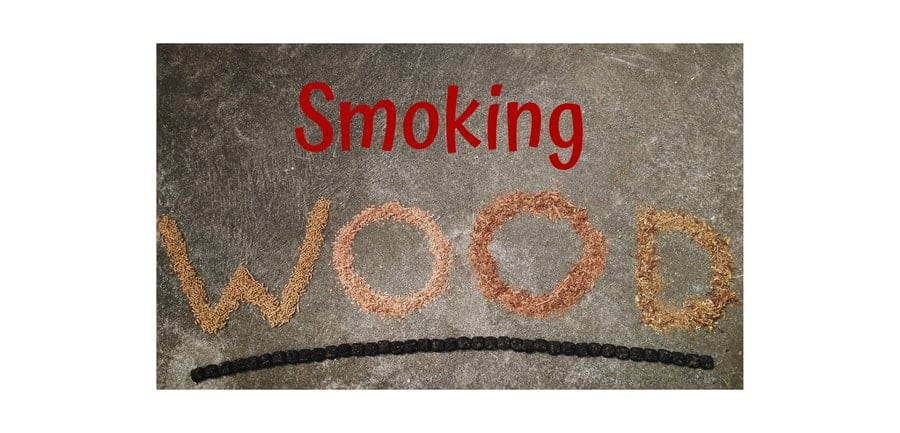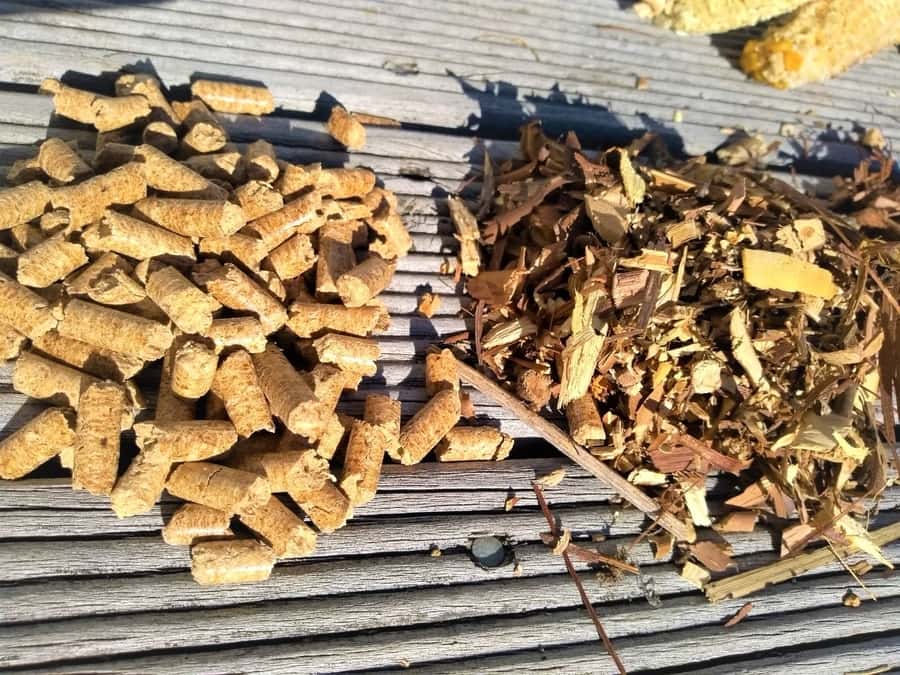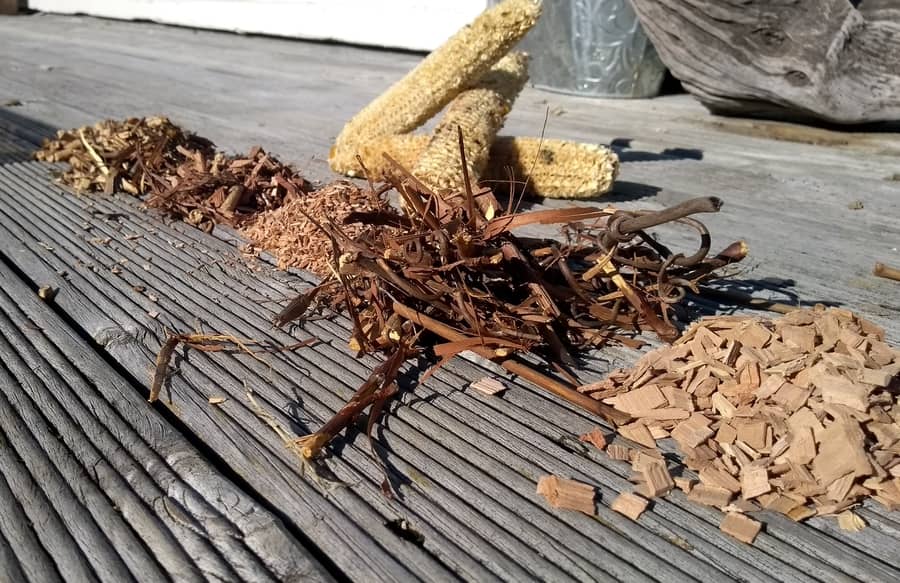Matching wood to meat can be simple, so I like to use universal smoking wood as a first choice. I’ll explain this in detail; it’s a simple and effective method of pairing smoking wood with different types of meat.
Some flavors are better suited to the more substantial types of smoking hardwood available.
From my experience, I think they all lie on a spectrum of light to strong. Light to medium wood has worked amazingly for most meats. Strong woods can be used by themselves, I prefer to mix them with lighter woods.
I buy pellets, get given fruit wood, and always have a lot of grape wood. However, given the opportunity, I have tried many different methods and wanted to share my thoughts.

Guide to Pairing Wood to Meat for Smoking
Use fruitwood or other medium wood for pork, poultry, fish, seafood, or vegetables. Intense heavy smoke works best for dense red meat or red game meat like Hickory, mesquite, and walnut. Mixing one-third strong and two-thirds light wood is also suitable for many meat smoking projects (I wrote another article on smoking wood for cured meats too).
Everyone’s taste buds are different, so the best way to figure out what you like is to try it.
I have found that less is better with smoking wood since too much can make the meat bitter. I learned my lesson from smoking fish fillets with stronger woods in the early days: bitter tang – unpleasant.

I have been fortunate over the years to get ‘homegrown’ wood from my trees and people I know. Although I still experiment with bought pellets for my smoke generator and pellet tube cold smoking (though I mix in wood chips with the pellets in the tube, too).
So, the goal here is to give you some confidence to have a go. But don’t be afraid of some experimentation down the track. I reckon pistachio nut shells add some ‘nuttiness’ to my smoked fish!
My matching of wood to meat is based on the density and the flavor strength of the meat; some meat like trout, seafood, and salmon are subtle compared to red meat like beef or (greyish/pink) meat pork (also considered red meat)
Lighter, less dense Meat – like fish, poultry, rabbit, hare
Medium Meats – Turkey, lamb
Dense meat – Pork, beef, venison, elk, reindeer, tahr or sheep (lamb a bit less dense)
Smoking Wood To Pair With Meat
Light Woods – for Fish, Seafood, and Poultry – mainly less dense meat
- Apple
- Alder
- Cherry
- Almond
- Mulberry
- Peach
- Grape Wood
- Many other fruit woods can be used
Medium Woods Fish, Poultry, some like wild turkey or chicken, red meat, wild large red meat, wild small game, wild game poultry.
All-rounder Woods works with most meats.
- Olive
- Beech (depending on species)
- Red Wine barrel chips (oak generally)
- Manuka
- Pohutakawa
- Pecan
- Oak
- Hickory
Strong Woods – Dense meat, ideally mixed with lighter or medium woods. Use sparingly, wild game and beef, or for a stronger smoke flavor.
- Walnut
- Mesquite
- Mahogany
Here are the smoking woods to pair in table format.
| Light Woods for Seafood, Fish, Small Game | Medium Woods – All Rounder | Strong Woods for Red Meat, Wild Game |
|---|---|---|
| Apple | Olive | Walnut |
| Alder | Beech | Mesquite |
| Cherry | Red Wine barrel chips (oak generally) | Mahogany |
| Almond | Manuka | Hickory |
| Mulberry | Pohutakawa | |
| Peach | Pecan | |
| Grape Wood | Oak |
Most fruit woods are universal, like apple and cherry, with lighter flavor.
I don’t like to think there are strict rules, and the above is to give some straightforward guidance to someone who needs help and is new to this craft, whether it’s cold, warm, or hot smoking.

How Much Wood for Smoking Meat?
As mentioned, less is best – nothing spoils a smoked meal more than over smoking.
For low & slow indirect hot smoking, two handfuls an hour for 3-5 hours; meat generally can’t take the smoke after that. However, it depends on the smoker you use. A pellet grill smoker uses about 1/2 pd to 1 pd an hour based on the brands I’ve used, like GMG and Traeger (for slow hot smoking in fast heat grilling).
In contrast, for fast, hot smoking in a portable smoker, I use half a handful (2 tablespoons) for 10-15 minutes on trout fillets.
Cold smoking in a smoker generator or pellet tube, I will use about 2-3 cups for 4-5 hours.
Which Wood Can I Smoke Food With?
In short, anything with resin or sap is no good. Trees that lose their leaves and are seasonal can typically be used. These are deciduous hardwoods as opposed to the evergreen types, which are green all year round.
If you want further info on types of woods you should and shouldn’t use, please find that article here.
Harvesting Wood for Smoking Food Tips
If you are gathering wood that isn’t bought, make sure it’s:
- Dry (not freshly cut) – all purchased wood is dried
- Deciduous Hardwood (not an evergreen, i.e., should be losing leaves in winter)
- No sap/oil/resin wood (like pine or conifer generally)
- Avoid cutting with a chainsaw; you don’t want chainsaw oil in your food!
- Ideally organic, not sprayed heavily with pesticides
Under Smoking, Not Over Smoking
When you over-smoke meat, which I’ve done with fish, all I had was strong wood, and I used too much. The outcome is a bitter kind of tangy flavor.
I had this idea that using more wood could get more woody flavor into the flesh. But that’s not how it works! You want to space out the smoke if you are in a long slow cook/smoke session.
I met a French man many years ago at a barbecue grill party; he made the most amazing smoked trout. He only used a few tablespoons of sawdust in a portable smoker. If you don’t know what a portable smoker is, it’s direct heat – link to a selection of these).. If you don’t know what a portable smoker is, I wrote a beginner’s post of all the different smoking techniques I have used; check it out here.
Stronger Woods for Denser Red Meat
So what I like to do with red meat is use about 60-75% light/medium wood and 40-25% strong dark wood like Hickory. Apple and Hickory go very well together for red meats!
In Central Europe and Eastern Europe, they have been smoking meat for hundreds and thousands of years. They have developed many long-standing smoked meat recipes, especially with red meat.
They focus on the strong wood flavors, and they smoke quite heavily compared to many other countries worldwide. A Dutch butcher friend was fond of mahogany offcuts from a local furniture maker.
In the wonderful world of brisket, you’ll find Apple and Cherrywood used even with no mixer woods. It just brings out some different flavors using lighter wood. Of course, again, it just depends on how much smoke flavor and what kind you like; the only way is to try it out and learn.
For Cold Smoked Bacon, I have had success with:
- Apple
- Alder
- Cherry
- Grape Wood
- Peach
- Pear
- Pohutakawa
- Maple
- Pecan
Wild Game Flavor & Beef Woods that worked amazing:
- Walnut
- Mesquite
- Hickory
Should I be Using the Bark for Smoking Meat?
I have used various different types of bark for light or heavy smoke sessions. I can’t say there’s been any issues with flavor or taste. So, to me, it seems to find the use for any smoking project.
Should I Soak My Wood for Smoking?
Don’t bother!
Soaking will penetrate the wood only slightly, like really slightly. It definitely delays the combustion in the smoke creation, so if that’s what you’re after.
Unless you want steam before the smoking starts, it just isn’t worth it. Moisture may also lead to less smoke adhering to the meat since a dried-out pellicle on meat will have more smoke attached to it. For more on pellicle formation on meat, check out a post here.
But it seems people are now realizing that soaking the wood, apart from delaying combustion, doesn’t really make any other difference to the flavor. I think it doesn’t seem to make the smoke last longer.
It does create moisture on the meat, which is useful for a pig on a spit, for instance.
Seasoning Wood for Smoking
Wood has something like 50% moisture when freshly cut.
9-12 months of drying for chunky wood is necessary, but I have found 6 months is ok for grape vines and small pieces.
Related Questions
Can I Mix Wood for Smoking?
Mixing strong woods with light woods is a good technique for developing preferences in smoke flavor. Mixing wood ratios of 2:1 or 3:1 for light and strong woods will yield quality outcomes.
Should I Soak Wood Before Smoking?
Soaking wood has little to no effect on helping the wood burn slower. Practically no penetration of water goes into the wood after 6 hours. Soaking wood creates a small amount of steam before combustion begins.

Tom Mueller
For decades, immersed in studying, working, learning, and teaching the craft of meat curing, sharing the passion and showcasing the world of charcuterie and smoked meat. Read More
